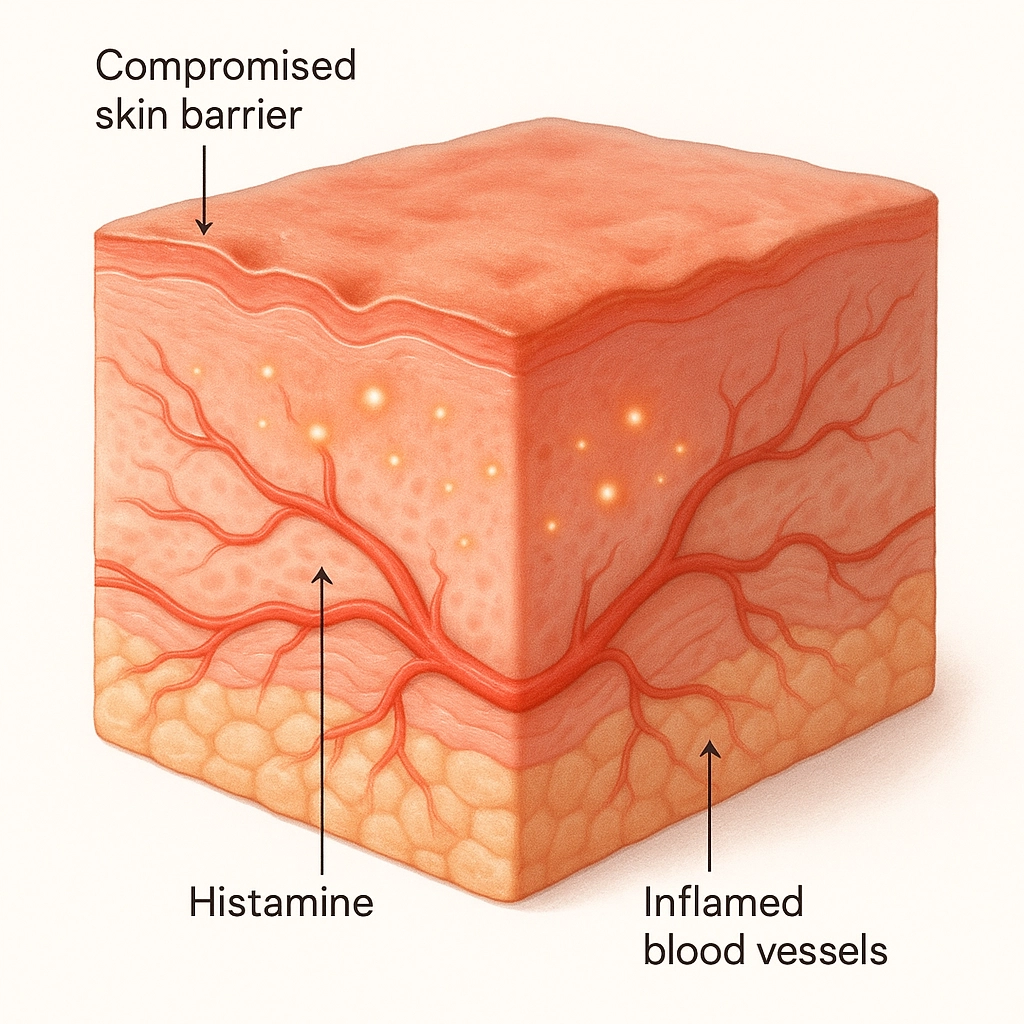If you think Arizona’s desert climate means fewer allergy problems, think again. Our unique desert environment creates some of the most challenging seasonal allergy conditions in the country, and your skin often bears the brunt of it. Unlike other regions where spring dominates allergy season, Arizona’s mild winters and year-round growing seasons mean pollen and allergens are almost always in the air—and that spells trouble for sensitive skin.
At Arizona Skin Institute, we see firsthand how seasonal allergies can wreak havoc on your skin, especially during our notorious winter pollen peaks when cedar, juniper, and desert plants release massive amounts of allergens into our dry, windy air. Understanding how these allergies affect your skin—and what you can do about it—can make all the difference in maintaining healthy, comfortable skin year-round.
How Seasonal Allergies Attack Your Skin
When your body encounters airborne allergens like pollen, it doesn’t just affect your nose and eyes. Your immune system launches a full-scale inflammatory response, releasing histamines that directly impact your skin in several ways. This immune reaction causes blood vessels to dilate, leading to redness, swelling, and that uncomfortable feeling of irritation that makes you want to scratch—which only makes things worse.
The inflammation from allergic reactions also compromises your skin’s natural barrier function. Think of your skin barrier as a protective brick wall—allergies essentially create cracks in that wall, allowing moisture to escape and irritants to penetrate more easily. This is why many people notice their skin becomes drier, flakier, and more sensitive during allergy season.

Arizona’s Unique Allergy Timeline
What makes Arizona particularly challenging is our inverted allergy season. While most of the country deals with peak pollen counts in spring and fall, Arizona’s allergy season peaks during our mild winter months—typically December through March. During this time, native desert plants like palo verde, mesquite, and various grasses release massive amounts of pollen into the dry air.
Our desert winds don’t help either. These breezes easily carry pollen particles across long distances, meaning you can experience allergic reactions even when you’re nowhere near the source. The low humidity that characterizes our climate also means pollen particles stay airborne longer and your skin is already fighting against moisture loss—a double whammy for skin health.
Common Skin Reactions During Arizona’s Allergy Season
Eczema Flare-ups are among the most common skin issues we see during allergy season. The body’s heightened immune response to allergens makes existing eczema much harder to manage. You might notice dry, red patches becoming more inflamed, itchy, and prone to cracking or oozing. These flare-ups often appear on the face, neck, hands, and other exposed areas.
Hives and Welts can develop suddenly when your skin comes into direct contact with pollen or when your body has a systemic allergic reaction. These appear as raised, red, itchy bumps that can range from small dots to large welts. They’re particularly frustrating because they can appear and disappear unpredictably.
Contact Dermatitis is especially common in Arizona due to our unique desert flora. Direct contact with plants like desert broom, ragweed, or even palo verde pollen can cause localized red, itchy, or blistering rashes. This is different from airborne allergic reactions—it’s your skin’s direct response to touching an allergen.
Periorbital Issues include those telltale dark circles, puffy eyes, and swollen eyelids that make you look like you haven’t slept in days. The delicate skin around your eyes is particularly susceptible to allergic inflammation, and constant rubbing from itchiness only makes the problem worse.
General Skin Dryness and Irritation often gets overlooked as an allergy symptom, but it’s incredibly common. The combination of allergic inflammation and Arizona’s dry climate creates a perfect storm for skin that feels tight, looks flaky, and becomes increasingly sensitive to products you normally tolerate well.

Arizona-Specific Management Strategies
Track Local Pollen Patterns: Arizona pollen counts can vary dramatically from day to day and even hour to hour. Pollen levels typically peak in the morning and late afternoon, so planning outdoor activities for evening hours can help minimize exposure. Many weather apps now include local pollen forecasts—use them to your advantage.
Create an Allergy-Safe Home Environment: Keep windows closed during high pollen days and rely on air conditioning instead of natural ventilation. Install HEPA filters on your HVAC system and change them regularly. The investment in good filtration pays off when you can retreat to a pollen-free space at the end of the day.
Post-Exposure Protocols: After spending time outdoors, immediately shower and wash your hair to remove sticky pollen particles. Change clothes and wash them promptly—pollen adheres easily to fabrics and can continue causing reactions hours after exposure. If you have pets, they need post-outdoor cleaning too, as they can carry pollen inside on their fur.
Strategic Outdoor Timing: When you do need to be outside during peak allergy season, choose your timing carefully. Early morning often has lower pollen counts than midday, and rainy days provide temporary relief by washing pollen out of the air.
Professional Skincare During Allergy Season
Strengthen Your Skin Barrier: Use gentle, fragrance-free moisturizers with ingredients like ceramides, hyaluronic acid, and niacinamide. These help repair the compromised skin barrier that allergic inflammation creates. Apply moisturizer while your skin is still slightly damp to lock in hydration—crucial in our dry climate.
Gentle Cleansing is Key: Switch to mild, non-irritating cleansers that remove pollen and allergens without further compromising sensitive skin. Avoid harsh scrubbing or exfoliation, which can worsen inflammation and make your skin more reactive.
Anti-Inflammatory Skincare: Look for products containing ingredients like colloidal oatmeal, aloe vera, or green tea extract, which can help calm irritated skin. However, be cautious with new products during allergy season—your skin may be more reactive than usual.
Cool Compresses for Acute Relief: For immediate relief from hives or swollen, irritated skin, apply cool, damp compresses for 10-15 minutes. This can help reduce inflammation and provide temporary comfort.
When to Seek Professional Help
If your skin reactions are severe, persistent, or interfering with your daily life, it’s time to see a dermatologist. At Arizona Skin Institute, we understand the unique challenges of managing skin health in our desert environment. We can help identify specific triggers, develop personalized treatment plans, and prescribe appropriate medications when over-the-counter options aren’t enough.
Red flags that warrant professional attention include: widespread hives, severe swelling (especially around the face and throat), skin infections from excessive scratching, or eczema that doesn’t respond to standard care. We can also help distinguish between allergic skin reactions and other skin conditions that might worsen during allergy season.
Building Long-Term Resilience
Managing allergy-related skin issues in Arizona requires a year-round approach, not just seasonal intervention. Regular moisturizing, sun protection, and gentle skincare habits help maintain your skin’s barrier function, making it more resilient when allergy season hits.
Consider keeping a skin diary to track patterns—noting when flare-ups occur, what you were exposed to, and which treatments help can provide valuable insights for both you and your dermatologist.
Arizona’s unique desert environment doesn’t have to mean suffering through seasonal skin problems. With the right knowledge, preparation, and professional support when needed, you can maintain healthy, comfortable skin even during our challenging pollen peaks. Remember, managing allergy-related skin issues is a marathon, not a sprint—consistency with gentle, supportive skincare practices will serve you well throughout Arizona’s extended allergy seasons.
If you’re struggling with persistent skin reactions during allergy season, don’t hesitate to contact Arizona Skin Institute for personalized care that takes our unique desert environment into account.
Shingles: Symptoms, Causes, and Treatment
Shingle is a type of itchy rash caused by the reactivation of the varicella-zoster virus, which is also responsible for chickenpox. Dr. Jay Mehta and his team of dermatologists regularly treat...
Common Nail Disorder Conditions and Treatments
Nail disorders are a broad category of illnesses that impair the look of one's fingernails and toes. Your nails can disclose a lot about your health. Infections produced by bacteria, fungi, or...
How to Make My Face Clear and Glowing Naturally?
Clear, glowing skin is synonymous with health and vitality. To look your best, you need to incorporate certain lifestyle changes as part of your skincare routine. Moreover, products that you can...
Tips to help with Mask acne
Staying safe and considering others' safety has become important in today's world as we continue our fight against COVID-19. But even the most basic and necessary safety precautions can come with...
Skincare routine for sensitive skin
Great skin is not merely a matter of luck or DNA. In fact, your daily habits play a big role in what you see in the mirror. Taking some time to care for one's skin and body is no longer viewed as an...
Common Skincare Myths
Most people dream of having radiant, clear skin. But do you know, skin health is about more than just looking great? Skin is the largest organ in our body, and taking care of it is very important....
A Skin Health Experts’ Guide To Acne Skin Care.
Acne is a skin disease that is caused when hair follicles become clogged with dead skin cells and oil. This can cause pimples and nodules to develop on the skin. Acne doesn't just impact your skin...

